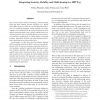Free Online Productivity Tools
i2Speak
i2Symbol
i2OCR
iTex2Img
iWeb2Print
iWeb2Shot
i2Type
iPdf2Split
iPdf2Merge
i2Bopomofo
i2Arabic
i2Style
i2Image
i2PDF
iLatex2Rtf
Sci2ools
111
click to vote
NDSS
2003
IEEE
2003
IEEE
Integrating Security, Mobility and Multi-Homing in a HIP Way
The current trend in mobile networking is towards mobile hosts that have multiple network interfaces, e.g., WLAN and GPRS. However, when the current Internet architecture was originally designed, neither mobility nor multihoming were considered. In the current architecture an IP address represents both a host’s identity and the host’s topological location. This overloading has led to several security problems, including the so called address ownership problem, making IP mobility and multi-homing unnecessarily hard from the security point of view. In this paper we show how the Host Identity Payload (HIP), being discussed at the IETF, can be used to simultaneously solve the security problems, and many of the practical problems, related to end-host multi-homing and endhost mobility. Basically, HIP introduces a new cryptographic name space and protocol layer between network and transport layers, breaking the fixed binding between identities and locations. The approach is especially s...
Computer Networks | Host Identity Payload | Host’s Topological Location | NDSS 2003 | Security Problems |
Related Content
| Added | 05 Jul 2010 |
| Updated | 05 Jul 2010 |
| Type | Conference |
| Year | 2003 |
| Where | NDSS |
| Authors | Pekka Nikander, Jukka Ylitalo, Jorma Wall |
Comments (0)

